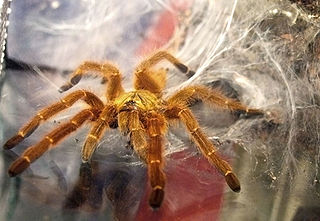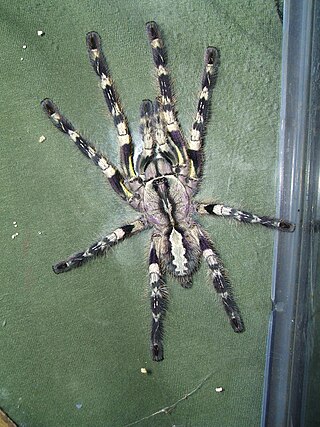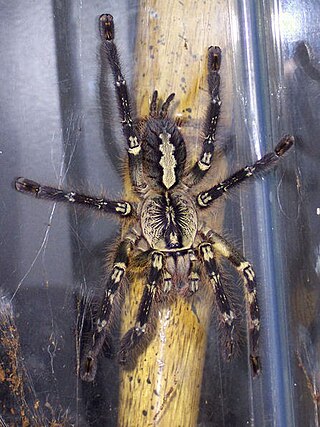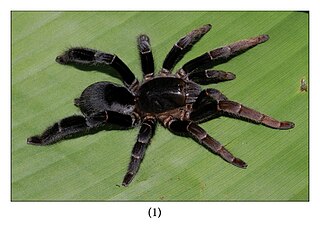
Huntsman spiders, members of the family Sparassidae, are known by this name because of their speed and mode of hunting. They are also called giant crab spiders because of their size and appearance. Larger species sometimes are referred to as wood spiders, because of their preference for woody places. In southern Africa the genus Palystes are known as rain spiders or lizard-eating spiders. Commonly, they are confused with baboon spiders from the Mygalomorphae infraorder, which are not closely related.

The Chilean rose tarantula, also known as the rose hair tarantula, the Chilean fire tarantula, or the Chilean red-haired tarantula, is probably the most common species of tarantula available in American and European pet stores today, due to the large number of wild-caught specimens exported cheaply from their native Chile into the pet trade. The species is also known from Bolivia and Argentina.

Brachypelma is a genus of spiders in the family Theraphosidae (tarantulas). They may have bodies up to 6 cm long with legs of similar or greater lengths. Some species have brightly colored legs, with red or orange marks and rings.

The Harpactirinae are a subfamily of tarantulas which are native to the continent of Africa. Like many Old World tarantulas, they have a relatively strong venom and can inflict a painful bite.

Pterinochilus murinus or the orange baboon tarantula, is a nocturnal spider in the family Theraphosidae that was first described in 1897 by Reginald Innes Pocock. This species is found in Angola, as well as central and southern Africa. It is a member of the subfamily Harpactirinae, baboon spiders.

Poecilotheria is a genus of tarantulas native to India and Sri Lanka. It was first described by Eugène Louis Simon in 1885. They are arboreal tarantulas, commonly known as ornamental tarantulas, known for their vivid color patterns, fast movement, and potent venom compared to other tarantulas. As of 2019 all species are protected under CITES.

Poecilotheria metallica, also known as the peacock tarantula, is an Old World species of tarantula. It is the only blue species of the genus Poecilotheria. Like others in its genus it exhibits an intricate fractal-like pattern on the abdomen. The species' natural habitat is deciduous forest in Andhra Pradesh, in central southern India. It has been classified as Critically endangered by the IUCN.

Aphonopelma chalcodes, commonly known as the western desert tarantula, desert blonde tarantula, Arizona blonde tarantula or Mexican blonde tarantula, is a species of spider belonging to the family Theraphosidae. It has a limited distribution in the deserts of Arizona and adjacent parts of Mexico but can be very common within this range. The common name "blonde tarantula" refers to the carapace, which is densely covered in pale hairs, and contrasts strongly with the all-dark legs and abdomen. Additionally, these spiders have low toxicity, a long life expectancy, and several offspring.

Poecilotheria regalis is a species of arboreal tarantula and is found in parts of India. The common name for this spider is Indian ornamental tree spider, or simply Indian ornamental. It is one of the most popular arboreal tarantulas for amateur collectors. Their leg span sometimes exceeds 7 inches (18 cm).

Tarantulas comprise a group of large and often hairy spiders of the family Theraphosidae. As of December 2023, 1,100 species have been identified, with 166 genera. The term "tarantula" is usually used to describe members of the family Theraphosidae, although many other members of the same infraorder (Mygalomorphae) are commonly referred to as "tarantulas" or "false tarantulas". Some of the more common species have become popular in the exotic pet trade. Many New World species kept as pets have setae known as urticating hairs that can cause irritation to the skin, and in extreme cases, cause damage to the eyes.
Hysterocrates gigas is a member of the tarantula family, Theraphosidae found in Cameroon. It is known as the giant baboon spider, Cameroon red baboon spider, or red baboon tarantula.

Pelinobius or the king baboon is a monotypic genus of east African tarantulas containing the single species, Pelinobius muticus. It was first described by Ferdinand Anton Franz Karsch in 1885, and is found in Tanzania and Kenya.

Heteroscodra is a genus of Central African tarantulas that was first described by Reginald Innes Pocock in 1900. Like many Old World tarantulas, they have a strong venom, and can inflict a painful bite. As of March 2020 it contains two species, found in Africa: H. crassipes and H. maculata.

Poecilotheria ornata, known as the fringed ornamental or ornate tiger spider, is a large arboreal tarantula, which is endemic to Sri Lanka. Their legspan sometimes reaches 10 inches (25 cm) in females, and is probably the second largest of the genus, behind Poecilotheria rufilata.

The Stromatopelminae are a subfamily of tarantulas native to West Africa and part of Central Africa. The subfamily was first proposed by Günter Schmidt in 1993.

Harpactira pulchripes, also known as the golden blue-legged baboon spider, is a bright yellow-bodied and metallic blue-legged tarantula found in South Africa. It was first described by Reginald Innes Pocock in 1901. It is a very highly desired tarantula in the European and American tarantula keeping hobby. Its specific name pulchripes is derived from Latin "pulchri" meaning beautiful, and "pes" meaning feet, forming the name beautiful feet.

Monocentropus balfouri is a tarantula in the Monocentropus genus, it was first described by Reginald Innes Pocock in 1897. This tarantula is also called Socotra Island Blue Baboon Tarantula, usually shortened to Blue Baboon Tarantula. This spider is named after its collector Isaac Bayley Balfour. It is found in Socotra Island, hence the common name. This tarantula is terrestrial and an opportunistic burrower. Like many tarantulas, M. balfouri can be kept as a pet, although it is not a beginner species.
Pterinochilus lugardi also known Grey starburst baboon, Dodoma baboon, Fort hall baboon or Tanzanian blonde baboon tarantula is a tarantula first described by Reginald Innes Pocock in 1900. They are found all over Southern and Eastern Africa, of course excluding Madagascar.

Lyrognathus giannisposatoi sometimes called the Sumatran stout leg tarantula is a tarantula which can be found in Mesuji Regency, Sumatra, Indonesia. It was first described by Steven C. Nunn, Rick C. West in 2013, and is named after Gianni Sposato, who helped with Selenocosmia material, and was of great help to the authors.
















